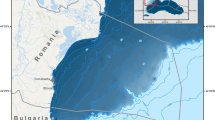Abstract
Toxic metal (Hg, Cd, Pb, Cu and Zn) concentrations of small-medium bluefish, anchovy and sardine in Istanbul, Turkey, were determined using inductively coupled plasma-mass spectrometry (ICP-MS) throughout 1 year. The concentrations of pollutants were found to vary according to season and species. Estimates of weekly intake levels of the metals were calculated and compared to recommended safe limits for fish consumption by humans. The levels of Cd, Pb, Cu and Zn in the fillets of all species resulted in estimates of weekly intake levels that were lower than the recommended safe limits. The concentrations of Hg of small bluefish in September, of medium bluefish in June and September, of anchovy in March, and of sardine in August and September resulted in estimates of weekly intake levels that were higher than the recommended safe limits for human consumption.
Similar content being viewed by others
References
Abou-Arab AAK, Ayesh AM, Amra HA, Naguib K (1996) Characteristic levels of some pesticides and heavy metals in imported fish. Food Chem 57:487–492
Adei E, Forson-Adaboh K (2008) Toxic (Pb, Cd, Hg) and essential (Fe, Cu, Zn, Mn) metal content of liver tissue of some domestic and bush animals in Ghana. Food Addit Contam B 1:100–105
Afonso C, Lourenço HM, Dias A, Nunes ML, Castro M (2007) Contaminant metals in black scabbard fish (Aphanopus carbo) caught off Madeira and the Azores. Food Chem 101:120–125
Aksu A, Balkıs N, Taşkin ÖS, Erşan MS (2011) Toxic metal (Pb, Cd, As and Hg) and organochlorine residue levels in hake (Merluccius merluccius) from the Marmara Sea, Turkey. Environ Monit Assess 182:509–521
Alkan N, Aktaş M, Gedik K (2012) Comparison of metal Accumulation in fish species from the southeastern Black Sea. Bull Environ Contam Toxicol 88:807–812
Belitz HD, Grosch W, Schieberle P (2001) Lehrbuch der Lebensmittelchemie, Aufl. Springer, Berlin. ISBN: 3-540-41096-1-5
Blanco SL, González JC, Vieites JM (2008) Mercury, cadmium and lead levels in samples of the main traded fish and shellfish species in Galicia, Spain. Food Addit Contam B 1:15–21
Burger J (2009) Risk to consumers from mercury in bluefish (Pomatomus saltatrix) from New Jersey: size, season and geographical effects. Environ Res 109:803–811
EPA (1994) Microwave assisted acid digestion of sediments, sludges, soils, and oils. Method 3051
Erkan N, Selçuk A, Özden Ö (2010) Amino acid and vitamin composition of raw and cooked horse Mackerel. Food Anal Method 3:269–275
European Commission (2006) Commission regulation (EC) no. 1881/2006 of 19 December 2006 setting maximum levels for certain contaminants in foodstuffs. Off J Eur Union L364-5/L364-24
FAO (1983) Compilation of legal limits for hazardous substances in fish and fishery products. FAO Fishery Circular no. 464, pp 5–100
FAO/WHO (2004) Summary of evaluations performed by the Joint FAO/WHO Expert Committee on Food Additives (JECFA 1956–2003) (first through sixty first meetings), ILSI Press International Life Sciences Institute
Galitsopoulou A, Georgantelis D, Kontominas M (2012) The influence of industrial-scale canning on cadmium and lead levels in sardines and anchovies from commercial fishing centres of the Mediterranean Sea. Food Addit Contam B 5:75–81
Görür FK, Keser K, Akcay N, Dizman S (2012) Radioactivity and heavy metal concentrations of some commercial fish species consumed in the Black Sea Region of Turkey. Chemosphere 87:356–361
Ikem A, Egiebor NO (2005) Assessment of trace elements in canned fishes (mackerel, tuna, salmon, sardines and herrings) marketed in Georgia and Alabama (United States of America). J Food Compos Anal 18:771–787
Keskin Y, Baskaya R, Özyaral O, Yurdun T, Lüleci NE, Hayran O (2007) Cadmium, lead, mercury and copper in fish from the Marmara Sea, Turkey. Bull Environ Contam Toxicol 78:258–261
Kucuksezgin F, Altay O, Uluturhan E, Kontas A (2001) Trace metal and organochlorine residue levels in red mullet (Mullus barbatus) from the eastern Aegean, Turkey. Water Res 35:2327–2332
Mol S (2011) Determination of trace metals in canned anchovies and canned rainbow trouts. Food Chem Toxicol 49:348–351
National Research Council (1980) Copper in recommended dietary allowances. Food Nutrition Board, NRC/NAS, Washington, DC, pp 151–154
SCOOP (2004) SCOOP 3.2.11: assessment of the dietary exposure to arsenic, cadmium, lead and mercury of the population of the EU members States. Directorate-General Health and Consumer Protection, European Union Brussels, Belgium
Sobukola OP, Adeniran OM, Odedairo AA, Kajihausa OE (2010) Heavy metal levels of some fruits and leafy vegetables from selected markets in Lagos, Nigeria. Afr J Food Sci 4:389–393
Staudinger MD (2011) Species- and size-specific variability of mercury concentrations in four commercially important finfish and their prey from the northwest Atlantic. Mar Pollut Bull 62:734–740
TUIK (2009). Fishery statistics. Turkey Statistical Institute
Turkish Food Codex (2002) Su Urunleri Yonetmeligi, official paper no. 24936, Ankara, Turkey
Tuzen M (2003) Determination of heavy metals in fish samples of the middle Black Sea (Turkey) by graphite furnace atomic absorption spectrometry. Food Chem 80:119–123
Tuzen M (2009) Toxic and essential trace elemental contents in fish species from the Black Sea, Turkey. Food Chem Toxicol 47:1785–1790
Uluozlu OD, Tuzen M, Mendil D, Soylak M (2007) Trace metal content in nine species of fish from the Black and Aegean Seas, Turkey. Food Chem 104:835–840
WHO (2001) Methodology for exposure assessment of contaminants and toxins in food. WHO, Geneva, Switzerland. Available: http://www.who.int/fsf.WHO/SDE/PHE/FOS/00.5. Cited 12 Feb 2007
Yusà V, Suelves T, Ruiz-Atienza L, Cervera ML, Benedito V, Pastor A (2008) Monitoring programme on cadmium, lead and mercury in fish and seafood from Valencia, Spain: levels and estimated weekly intake. Food Addit Contam B 1:22–31
Acknowledgments
This work was supported by the Research Foundation of Istanbul University, Project Number YÖP-22/02102006 and BYP-16726.
Author information
Authors and Affiliations
Corresponding author
Rights and permissions
About this article
Cite this article
Özden, Ö. Monitoring Programme on Toxic Metal in Bluefish (Pomatomus saltatrix), Anchovy (Engraulis encrasicolus) and Sardine (Sardina pilchardus) from Istanbul, Turkey: Levels and Estimated Weekly Intake. Bull Environ Contam Toxicol 90, 542–551 (2013). https://doi.org/10.1007/s00128-012-0958-3
Received:
Accepted:
Published:
Issue Date:
DOI: https://doi.org/10.1007/s00128-012-0958-3




